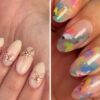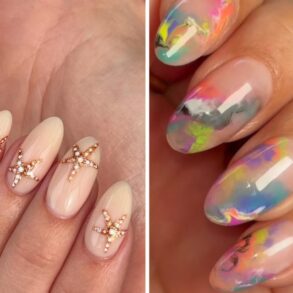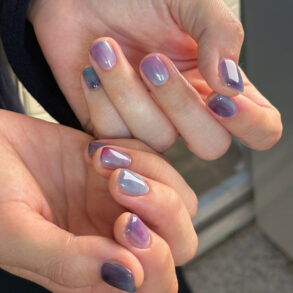
Today’s version of a traditional French manicure, the more thin “micro-French” tip, has been making a daintier statement. “A French manicure is the classic look with a nude or pink base and white tips,” editorial and celebrity nail artist, Aja Walton tells ESSENCE.
Meanwhile, “a micro-French manicure takes that classic look and adds a modern twist by making the white tips thinner and more delicate.” Seen on celebrities from Lori Harvey to JLo, the mani (also known as a “baby French”) pulls from both the red carpet favorite “non-icure” and classic white tip we can’t let go of.
Here, Walton tells us her expert-approved tips to giving your mani a micro point– and the best technique for every shape.
If you’re learning how to paint a precise micro-French manicure, the first step is making sure you have all the right tools. In addition to a clear base and top coat, pull out your “sheer nude or light pink polish for the base color and an opaque white polish for the tips,” Walton says.
For optimal precision, use a long, thin liner brush for the tips and a fine-tipped square or round brush to refine the style, she recommends. “Look for brushes specifically designed for nail art to ensure precision,” Walton says. “These style brushes are also great for cleaning up excess polish and achieving crisp lines around the nails.” Although, you should still have acetone on hand to clean up any mistakes or uneven edges for a more refined micro-tip.
Prep
“Start by shaping the nails to the desired length and gently push back the cuticles,” she says. At this point you can use a Russian style nail prep if preferred, working with a fine drill bit to file the cuticle. Then, “buff the surface of the nails to create a smooth canvas for polish application.”
Base coat
Next, “apply a clear base coat and allow it to dry completely,” she says. “Clear base coats protect the natural nail and ensure smooth polish application.” Using a base coat will act as the foundation for the following steps, which can also help your manicure last longer.
Pick and apply color
Now it’s time to pick your color. As mentioned before, a sheer nude or light pink polish will be the first color coat, which is the same process behind a traditional French manicure. “Paint a thin layer of the chosen base color onto the entire nail,” she says. “Make sure to apply evenly by keeping the brush completely parallel to the nail,” before allowing it to dry completely.
Paint thin tips
Arguably the most difficult part, “using the white polish, carefully paint thin white tips on each nail,” Walton says. “Start from one side and gently drag the brush across to the other side, creating a delicate line,” letting the natural curve of your nail guide you. Unlike traditional tips, the micro-French tip is much thinner, so “you can use a nail art brush for more precision if needed.”
Seal with a top coat
“Once the design is perfected, apply a clear top coat over the entire nail,” she says. “Clear top coat to seal in the colors and add shine to the finished manicure.”
“The technique for creating a micro-French manicure can vary depending on the nail shape,” she says. For the traditional square nail, the process is straightforward: “paint thin white tips in a straight line across the edge of the nail, ensuring they are uniform in width and parallel to the nail’s edge.”
However, for a round shape, you’re following the natural curve of the nail while painting the tips. To do this, Walton recommends you “start the white tips slightly lower on the sides and gradually build them up towards the center to maintain a balanced look.”
When painting on an almond or stiletto nail, elongation is key to compliment the shape of the nail. “Begin the white tips closer to the center of the nail and taper them to a point for almond nails or extend them further for stiletto nails,” she says. Finally, for coffin and ballerina nails, the white tips should follow the shape’s squared-off edge similar to square nails. These should all have a more parallel tip.
Painting a straight line is not easy, but for the micro-French tip, it is crucial. “Crooked lines can easily make this manicure appear sloppy and unprofessional,” Walton says. “Take your time and work with patience and precision,” keeping a consistent depth across the tip of every nail.
To do this, she recommends wiping your brush off a few times after dipping into the paint for even coverage across all the bristles. All while not overlapping the base color onto the white tips. “Keep the colors separate to maintain the crisp contrast of the French manicure.”
“Cleaning up any mistakes or uneven edges is vital to mastering this look,” she says. If you make a mistake, she recommends you use a thin round or square brush dipped in acetone or nail polish remover to clean it up. “This step ensures crisp and precise lines for the micro-French look.”
This post was originally published on this site be sure to check out more of their content.







